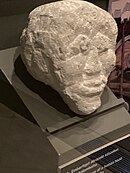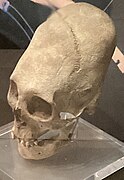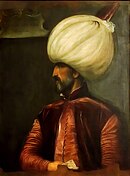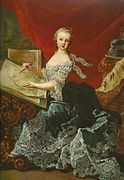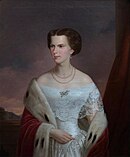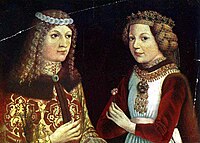Hungarian National Museum
 | |
 Museum building in 2006 | |
 | |
| Established | 1802 |
|---|---|
| Location | Erzsébetváros, Budapest, Hungary |
| Coordinates | 47°29′28″N 19°03′46″E / 47.49111°N 19.06278°E |
| Website | mnm |

The Hungarian National Museum (Hungarian: Magyar Nemzeti Múzeum, pronounced [ˈmɒɟɒr ˈnɛmzɛti ˈmuːzɛum]) was founded in 1802 and is the national museum for the history, art, and archaeology of Hungary, including areas not within Hungary's modern borders, such as Transylvania; it is separate to the collection of international art in the Hungarian National Gallery. The museum is in Budapest VIII in a Neoclassical building, purpose-built during 1837–47 by the architect Mihály Pollack.[1]
History
[edit]
The Hungarian National Museum traces its foundation to 1802, when Count Ferenc Széchényi set up the National Széchényi Library. This would then be followed a year later by the donating of a mineral collection by Széchényi's wife. This led to the creation of the Hungarian National Museum as a general history and natural history museum, beyond being simply a library. In 1807, the Hungarian National Parliament passed legislation on the new institution and asked the nation to help donate to the museum.
The Hungarian Parliament of 1832–1834 helped with the growth of the museum as well. The parliament voted in favor of giving half a million forints to help with the construction of a new building for the museum. During this time the Hungarian National History Museum was officially set up under the Hungarian National Museum. Later, in 1846, the museum moved to its current location of VIII. Múzeum krt. 14–16, where the museum resides in a neo-classical style building designed by Mihály Pollack.
In 1848, the Hungarian National Museum played a major role in the Hungarian Revolution. The Revolution was partially spurred by the reading of Sándor Petőfi's 12 points and the famous poem Nemzeti dal on the front steps of the museum. This helped make the museum a major site of national importance and identity for Hungary. In remembrance of the revolution, two statues were added to the museum: the first is a statue of János Arany, unveiled in 1883. In 1890, there was a statue next to the stairs of the museum of a memorial tablet to Sándor Petőfi. Additionally, during this time, the Upper House of the parliament held its sessions in the Cereminial of the museum. This continued until the new house of Parliament was built. Today, festivities held in remembrance of the National Commemorations Day of 1848 are held in front of the museum.
In 1949, an act split the ethnographic and natural history part of the Hungarian National Museum off of the main museum. They now comprise the Hungarian Natural History Museum and Ethnographic Museum. This also helped with the setting up of the modern day National Széchényi Library. All of these separate museums are still interconnected, and other museums and monuments have become affiliated with them over time. The most recent addition was the Castle Museum in Esztergom, which joined in 1985.
Exhibitions
[edit]
The Hungarian National Museum has seven permanent displays. The general history of Hungary is covered in two sections: the archaeology from prehistory to the Avar period ending in 804 AD on the first (ground) floor ("On the East-West frontier"), and the history from 804 to modern times on the first floor. This display covers topics such as the age of the Arpads, the long Turkish occupation, Transylvania and royal Hungary. More modern and Contemporary history covered begins with the Rákóczi War of Independence, showing different sections of his military attire and various coins. The history section then ends with the rise and fall of the communist system in Hungary. In another hall on the second floor one can find out about the Scholar Hungarians who made the twentieth century. A room on the first floor displays the medieval Hungarian Coronation Mantle.[2]
The ground floor's permanent exhibit is focused on Medieval and Early Modern stone inscriptions and carvings. This exhibit looks at various stone relics and the carvings that have been made into them. The majority of the items in this collection were discovered during the 1960s and 1970s, since they looked for more relics post World War II. The final permanent exhibit is placed in the basement of the museum. This is the Roman Lapidary exhibit, which is a collection of ancient Roman stone inscriptions and carvings.[3]
Building
[edit]
The building where the Hungarian National Museum is currently located was built from 1837 to 1847. The style of the main building was laid out in a neo-classical style and was added onto by other artists in the form of statues, paintings and other architecture. The statues of the Portico were done by Raffael Monti of Milan. One of these is a famous statue of the allegoric figure of Hungary, holding a shield with the Hungarian coat of arms on it. On the sides of this figure there is Science on one and Art on the other. In addition the paintings that have been in the staircase and on the ceiling since 1875 were done by Károly Lotz and Mór Than. There has also been a garden that is used primarily for various concerts. Various artists have performed here including Ferenc Liszt. Today the garden is the venue of the Museum Festival.
Scenes from the movie Evita, starring Madonna were filmed on the steps leading in. The scenes depicted the coffin of Eva Peron being carried into a 'Buenos Aires' government building to lay in State.
Departments
[edit]- Semmelweis Museum of Medical History (since 2017)
Controversies
[edit]On 28 October 2023, the Hungarian ministry of culture and innovation ordered the museum to prevent minors from viewing the annual World Press Photo exhibition it was hosting as part of its child protection law against "sexual propaganda". The exhibition, which included five photographs of elderly members of the LGBTQ+ community in the Philippines taken by Hannah Reyes Morales, was the subject of a complaint by MP Dora Duro from the far-right Our Homeland Movement.[4] World Press Photo executive director Joumana El Zein Khoury expressed surprise over the decision, and said there was "nothing explicit or offensive in these images". In response, the museum said it "cannot legally enforce" the order as it cannot ask for identity cards.[5] It later issued a notice on its website and at the entrance to the exhibition that the collection was restricted to visitors over 18.[6]
On 6 November, culture minister János Csák dismissed the museum's director, Laszlo Simon, who had assumed the position for a five-year term in 2021, citing his failure to comply with the said law and "engaging in conduct which made it impossible for him to continue his employment". In response, Simon wrote that he took "note of the decision" but could not "accept it", adding that he firmly rejected "the idea that our children should be protected from me or from the institution I run."[6]
Gallery
[edit]Archaeological collection
[edit]-
Neolithic female figure
-
Neolithic female figure
-
Bronze Age (?) skeleton
-
Iron Age stone head / idol
-
Elongated skull, female, post-Roman period
Portraits
[edit]-
Portrait of Suleiman the Magnificent (1494–1566)
-
Portrait of Ferdinand I, Holy Roman Emperor, c. 1530
-
Louis II of Hungary, 16th century
-
Mrs. Schodel in the Role of Elisabeth Szilágyi, Miklós Barabás, 1852
-
Portrait of the Empress Elisabeth of Austria, Josef Weidner, 1855
Paintings
[edit]-
Louis II and Mary of Hungary, unknown artist, c. 1515
-
Silver mine, Kutna Hora, unknown painter, 15th century
-
Siege of Buda (1686), Frans Geffels, 17th century
-
Dame in White Lace Dress, Ernestine Sehwag, 19th century
See also
[edit]References
[edit]- ^ "Alkotások honlapja :: Magyar Nemzeti Múzeum". BÉK -- a Budapesti Építész Kamara honlapja. Archived from the original on 2016-03-04. Retrieved 2009-03-27.
- ^ "The coronation mantle". Hungarian National Museum. Archived from the original on 3 May 2017. Retrieved 20 July 2016.
- ^ "Roman Lapidary". Hungarian National Museum. Archived from the original on 3 May 2017. Retrieved 20 July 2016.
- ^ Spike, Justin (1 November 2023). "Hungary bans teenagers from visiting World Press Photo exhibition over display of LGBTQ+ images". Associated Press. Retrieved 2 November 2023.
- ^ "Hungary LGBTQ content law unenforceable at top photo show: museum". France 24. 1 November 2023. Retrieved 2 November 2023.
- ^ a b Spike, Justin (6 November 2023). "Hungary has fired the national museum director over LGBTQ+ content in World Press Photo exhibition". Associated Press. Retrieved 6 November 2023.
| Hungarian art |
|---|
 |
| List of Hungarian painters |
| List of Hungarian sculptors |
| Hungarian National Gallery |
| Museum of Fine Arts |
External links
[edit]- Official website

- Museums in Budapest Archived 2020-08-24 at the Wayback Machine—(in Hungarian)
- Hungarian National Museum
- Museums in Budapest
- National museums of Hungary
- Art museums and galleries in Hungary
- Archaeological museums in Hungary
- History museums in Hungary
- Museums of ancient Rome in Hungary
- Buildings and structures completed in 1802
- Museums established in 1802
- 1802 establishments in the Habsburg monarchy
- 19th-century establishments in Hungary
- Landmarks in Hungary
- Neoclassical architecture in Hungary




